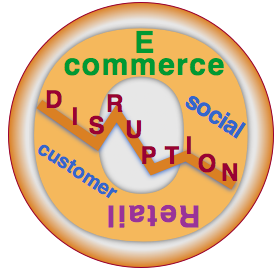Empowered customers and omni-channel commerce are mirrors of each other, and both are transforming “retail.”
 [UPDATED] Connected customers have the Internet in their pockets and use mobile and other devices in all stages of conceptualizing, considering, evaluating, buying and using purchased products and services. These customers want to interact with firms and brands in a seamless experience that features single sign-on as an entry point; they want the firm to respond using their individual data when that makes interacting more valuable. Omni-channel commerce refers to a collection of technologies, practices and strategies firms use to provide the personal individualized experience that connected customers expect. [UPDATED] Connected customers have the Internet in their pockets and use mobile and other devices in all stages of conceptualizing, considering, evaluating, buying and using purchased products and services. These customers want to interact with firms and brands in a seamless experience that features single sign-on as an entry point; they want the firm to respond using their individual data when that makes interacting more valuable. Omni-channel commerce refers to a collection of technologies, practices and strategies firms use to provide the personal individualized experience that connected customers expect.
IBM’s 2012 study of retail customers in eight mature economies (Australia, Canada, France, Italy, Japan, Spain, the UK and the USA) and seven growth economies (Argentina, Brazil, Chile, China, Colombia, Mexico and South Africa) lays bare that the retail “shopping” experience has shifted profoundly, although you wouldn’t know it by looking at most offline or online retailers’ presences. The paper, “Winning over the empowered consumer: Why trust matters,” is a call to […]
 Personal Individualized Experience is the DNA of digital transformation. It refers to using an optimal mix of people and digital technologies to provide personal interactions at scale, so it’s central to the mission of chief digital officers and CEOs and boards who hire them. Prior to digital and social technologies, organizations faced a trade-off between “personal” and “efficient” interactions with their stakeholders (customers, clients, employees, partners, regulators… hereafter “users”). Now this is no longer true; they can provide personal interactions at scale, once they learn how and where to interact efficiently and authentically. Personal Individualized Experience is the DNA of digital transformation. It refers to using an optimal mix of people and digital technologies to provide personal interactions at scale, so it’s central to the mission of chief digital officers and CEOs and boards who hire them. Prior to digital and social technologies, organizations faced a trade-off between “personal” and “efficient” interactions with their stakeholders (customers, clients, employees, partners, regulators… hereafter “users”). Now this is no longer true; they can provide personal interactions at scale, once they learn how and where to interact efficiently and authentically.
Used well, digital and social technologies retain an authentic human element while digitizing key aspects of relating to people. Therefore, organizations/firms/brands (hereafter “firms”) can now provide the Personal Individualized Experience (PIE). This post explains the three components of PIE and shows how firms can use them to build and maintain authentic and profitable relationships with users.
[…]
 To kick off Q3 2012, CSRA unveiled a new web presence that introduces new features to educate executives about social business—and creates one source to access CSRA thought leadership and to interact with us. Existing blogs will remain up, but their roles and functionality have been tweaked. Read on for a summary of the changes and how you can use them to raise your game in social business. To kick off Q3 2012, CSRA unveiled a new web presence that introduces new features to educate executives about social business—and creates one source to access CSRA thought leadership and to interact with us. Existing blogs will remain up, but their roles and functionality have been tweaked. Read on for a summary of the changes and how you can use them to raise your game in social business.
[…]
 ZDNet reports on “research” that finds that websites provide 7 times more sales leads than “social media.” Unfortunately, the writer doesn’t appreciate the self-irony in the second paragraph: “A company’s corporate website was found to be the top source of new sales leads online — second only to personal referrals..” ZDNet reports on “research” that finds that websites provide 7 times more sales leads than “social media.” Unfortunately, the writer doesn’t appreciate the self-irony in the second paragraph: “A company’s corporate website was found to be the top source of new sales leads online — second only to personal referrals..”
As B2B continues to adopt social business, more word of mouth, i.e. personal referrals, happens online. Another reason I’m calling out this post is that it misinforms readers by treating “sales leads” as a homogeneous category. Our clients don’t care about general adoption; what’s more relevant is adoption by their prospects. This post treats all leads as the same, so it’s really the equivalent of informational fast food.
To end on a dour note, misinformation can work to your advantage because your rivals may read it and believe while you can see through it, invest and pull ahead.
 In case you missed it, this seminal post from the New York Times shows a startling example of “big data” hitting retail. Data collection and mining have enabled Target, for example, to predict what degree of pregancy young mothers are in—based on the kind of things they buy. In case you missed it, this seminal post from the New York Times shows a startling example of “big data” hitting retail. Data collection and mining have enabled Target, for example, to predict what degree of pregancy young mothers are in—based on the kind of things they buy.
Although Valley visionaries and enterprise data engineers have been talking about “big data” for years, this post brings it down to the personal retail level. Due to the growing appreciation of social data and behavior, data scientists and marketers now have the glue to use data to increase relevance to customers and clients.
In this post’s main example, data engineers analyzed purchase behavior of pregnant mothers, sifting through voluminous retail data, and they found plenty of patterns that indicated that women were pregnant, down to the trimester! Obviously, enterprises have a large responsibility to use data in ways that won’t violate trust, and many will make mistakes in their efforts to pump up quarterly numbers.Put another way, buying transactions are *very* social, so retailers, whether bricks and mortar or ecommerce, will unleash tremendous intelligence in […]
Pithy insights on major Web 2.0 transformation driver: reflecting on the significance of Facebook Connect and Google Friendconnect, which offer Web 2.0 single signon services […]
Companies must take an ecosystem-focused approach to website design in the Web 2.0 era; site-centric design is a relic of the past […]
|
|
 [UPDATED] Connected customers have the Internet in their pockets and use mobile and other devices in all stages of conceptualizing, considering, evaluating, buying and using purchased products and services. These customers want to interact with firms and brands in a seamless experience that features single sign-on as an entry point; they want the firm to respond using their individual data when that makes interacting more valuable. Omni-channel commerce refers to a collection of technologies, practices and strategies firms use to provide the personal individualized experience that connected customers expect.
[UPDATED] Connected customers have the Internet in their pockets and use mobile and other devices in all stages of conceptualizing, considering, evaluating, buying and using purchased products and services. These customers want to interact with firms and brands in a seamless experience that features single sign-on as an entry point; they want the firm to respond using their individual data when that makes interacting more valuable. Omni-channel commerce refers to a collection of technologies, practices and strategies firms use to provide the personal individualized experience that connected customers expect.
 Personal Individualized Experience is the DNA of digital transformation. It refers to using an optimal mix of people and digital technologies to provide personal interactions at scale, so it’s central to the mission of chief digital officers and CEOs and boards who hire them. Prior to digital and social technologies, organizations faced a trade-off between “personal” and “efficient” interactions with their stakeholders (customers, clients, employees, partners, regulators… hereafter “users”). Now this is no longer true; they can provide personal interactions at scale, once they learn how and where to interact efficiently and authentically.
Personal Individualized Experience is the DNA of digital transformation. It refers to using an optimal mix of people and digital technologies to provide personal interactions at scale, so it’s central to the mission of chief digital officers and CEOs and boards who hire them. Prior to digital and social technologies, organizations faced a trade-off between “personal” and “efficient” interactions with their stakeholders (customers, clients, employees, partners, regulators… hereafter “users”). Now this is no longer true; they can provide personal interactions at scale, once they learn how and where to interact efficiently and authentically. To kick off Q3 2012, CSRA unveiled a new web presence that introduces new features to educate executives about social business—and creates one source to access CSRA thought leadership and to interact with us. Existing blogs will remain up, but their roles and functionality have been tweaked. Read on for a summary of the changes and how you can use them to raise your game in social business.
To kick off Q3 2012, CSRA unveiled a new web presence that introduces new features to educate executives about social business—and creates one source to access CSRA thought leadership and to interact with us. Existing blogs will remain up, but their roles and functionality have been tweaked. Read on for a summary of the changes and how you can use them to raise your game in social business. ZDNet reports on “research” that finds that websites provide 7 times more sales leads than “social media.” Unfortunately, the writer doesn’t appreciate the self-irony in the second paragraph: “A company’s corporate website was found to be the top source of new sales leads online — second only to personal referrals..”
ZDNet reports on “research” that finds that websites provide 7 times more sales leads than “social media.” Unfortunately, the writer doesn’t appreciate the self-irony in the second paragraph: “A company’s corporate website was found to be the top source of new sales leads online — second only to personal referrals..”